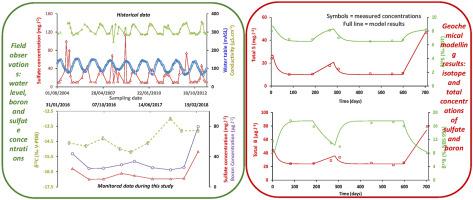当前位置:
X-MOL 学术
›
Appl. Geochem.
›
论文详情
Our official English website, www.x-mol.net, welcomes your feedback! (Note: you will need to create a separate account there.)
Cyclic variations of sulfate and boron concentrations and isotopes in deep groundwaters in the Aquitaine Basin, France
Applied Geochemistry ( IF 3.4 ) Pub Date : 2020-12-01 , DOI: 10.1016/j.apgeochem.2020.104818 Laurent André , Jean-Charles Manceau , Pierre Bourbon , Arnaud Wuilleumier
Applied Geochemistry ( IF 3.4 ) Pub Date : 2020-12-01 , DOI: 10.1016/j.apgeochem.2020.104818 Laurent André , Jean-Charles Manceau , Pierre Bourbon , Arnaud Wuilleumier

|
Abstract Concentrations and isotope contents of major and trace elements are principal factors in determining the origin of the chemical composition of groundwater. This paper focuses specifically on the use of sulfur and boron isotopes to characterize the origin of cyclic variations in the deep Eocene aquifer in the Aquitaine sedimentary basin (southwest of France). It is part of a multi-layer system mainly composed of sands and sandstone deposits. Groundwater contained in this deep reservoir is known to present stable chemical compositions, allowing its use for various purposes like drinking water, geothermal energy, thermal activity and agricultural irrigation. However, among the dozens of wells exploiting this aquifer and despite the reservoir’s substantial depth, variations in sulfate concentration have been identified in a limited area of the reservoir. These fluctuations are cyclic and they seem to be correlated with water level variations due to gas storage activities nearby in the same aquifer. Regular water samplings and analyses of major and trace elements and their isotopes have identified that bore concentration variations are correlated with sulfate variations. A geochemical modelling approach based on water mixes elucidates the causes of these variations in chemical composition, especially the boron and sulfate concentrations and their respective δ11B and δ34SSO4 values. From these numerical results, we identify that different sources explain the variations of boron concentration, one part coming from the silicates alteration (present in sub-layers of the exploited aquifer) and the other part coming from the evaporites alteration (present in the underlying molasse unit). These results also confirm the existence of mass and potentially water transfers between the different sub-layers of the reservoir and with the underlying molasse aquitard, implying new constraints for the future hydrogeologic modelling.
中文翻译:

法国阿基坦盆地深层地下水中硫酸盐和硼浓度和同位素的循环变化
摘要 主要和微量元素的浓度和同位素含量是决定地下水化学成分来源的主要因素。本文特别关注使用硫和硼同位素来表征阿基坦沉积盆地(法国西南部)深部始新世含水层中周期性变化的起源。它是主要由砂和砂岩矿床组成的多层系统的一部分。众所周知,这个深层水库中的地下水具有稳定的化学成分,可用于饮用水、地热能、热活动和农业灌溉等各种用途。然而,在开发该含水层的数十口井中,尽管水库很深,已在储层的有限区域内发现硫酸盐浓度的变化。这些波动是周期性的,它们似乎与同一含水层附近储气活动引起的水位变化有关。对主要和微量元素及其同位素的定期水采样和分析已经确定钻孔浓度变化与硫酸盐变化相关。基于水混合物的地球化学建模方法阐明了这些化学成分变化的原因,尤其是硼和硫酸盐浓度及其各自的 δ11B 和 δ34SSO4 值。从这些数值结果中,我们确定不同来源解释了硼浓度的变化,一部分来自硅酸盐蚀变(存在于已开发含水层的亚层),另一部分来自蒸发岩蚀变(存在于下层磨拉石单元)。这些结果还证实了储层不同亚层之间以及与下面的磨拉石透水层之间存在质量和潜在的水转移,这意味着对未来水文地质建模的新限制。
更新日期:2020-12-01
中文翻译:

法国阿基坦盆地深层地下水中硫酸盐和硼浓度和同位素的循环变化
摘要 主要和微量元素的浓度和同位素含量是决定地下水化学成分来源的主要因素。本文特别关注使用硫和硼同位素来表征阿基坦沉积盆地(法国西南部)深部始新世含水层中周期性变化的起源。它是主要由砂和砂岩矿床组成的多层系统的一部分。众所周知,这个深层水库中的地下水具有稳定的化学成分,可用于饮用水、地热能、热活动和农业灌溉等各种用途。然而,在开发该含水层的数十口井中,尽管水库很深,已在储层的有限区域内发现硫酸盐浓度的变化。这些波动是周期性的,它们似乎与同一含水层附近储气活动引起的水位变化有关。对主要和微量元素及其同位素的定期水采样和分析已经确定钻孔浓度变化与硫酸盐变化相关。基于水混合物的地球化学建模方法阐明了这些化学成分变化的原因,尤其是硼和硫酸盐浓度及其各自的 δ11B 和 δ34SSO4 值。从这些数值结果中,我们确定不同来源解释了硼浓度的变化,一部分来自硅酸盐蚀变(存在于已开发含水层的亚层),另一部分来自蒸发岩蚀变(存在于下层磨拉石单元)。这些结果还证实了储层不同亚层之间以及与下面的磨拉石透水层之间存在质量和潜在的水转移,这意味着对未来水文地质建模的新限制。

























 京公网安备 11010802027423号
京公网安备 11010802027423号